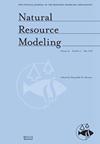Evaluating feedback dynamics between poaching and population with an application to Indian tigers
IF 2.1
4区 环境科学与生态学
Q3 ENVIRONMENTAL SCIENCES
引用次数: 0
Abstract
Abstract A cornerstone of conservation policy for endangered species subject to illegal harvest involves estimating their population and offtake numbers. Census enumerations are expensive to conduct on nationwide scales, especially in resource‐constrained countries housing such species. Resource and data limitations necessitate the estimation of population counts. The effect of poaching on species recruitment is often ignored in scientific population projections. Estimation of population counts should account for the interactive feedback between harvest and recruitment. Data on tiger population sizes and poaching from 51 reserves in India between 1994 and 2022 were obtained to calibrate a coupled ecological‐economic model of tiger population dynamics and poaching. Cobb–Douglas harvest functions with differing degrees of concavity and scale economies are used to characterize the economics of poaching. Population dynamics are evaluated using exponential and critical depensation growth functions. The predictive abilities of linked models and their parameter parsimony are evaluated using information criteria. Poaching is shown to substantially affect recruitment dynamics and is best characterized by a Schaefer function coupled with critical depensation growth. This paper provides a novel perspective of the interaction between tiger poaching and population dynamics in India. A systematic understanding of coupled ecological‐economic processes would improve the management of high‐value endangered species.以印度虎为例评估偷猎与种群间的反馈动态
濒危物种非法捕捞保护政策的基石之一是对其种群数量和摄取量的估计。在全国范围内进行人口普查是昂贵的,特别是在拥有这些物种的资源有限的国家。由于资源和数据的限制,必须估计人口数量。在科学的种群预测中,偷猎对物种补充的影响往往被忽视。对种群数量的估计应考虑到收获和招募之间的互动反馈。为了校准老虎种群动态和偷猎的耦合生态-经济模型,研究人员获得了1994年至2022年间印度51个保护区的老虎种群规模和偷猎数据。具有不同程度的凹度和规模经济的科布-道格拉斯收获函数被用来描述偷猎的经济特征。使用指数和临界依赖增长函数来评估种群动态。利用信息准则对关联模型的预测能力和参数简约性进行了评价。偷猎被证明对招聘动态有实质性影响,其最佳特征是Schaefer函数与临界依赖增长相结合。本文提供了一个新的视角来研究印度老虎偷猎与种群动态之间的相互作用。对生态-经济耦合过程的系统认识将有助于提高高价值濒危物种的管理水平。
本文章由计算机程序翻译,如有差异,请以英文原文为准。
求助全文
约1分钟内获得全文
求助全文
来源期刊

Natural Resource Modeling
环境科学-环境科学
CiteScore
3.50
自引率
6.20%
发文量
28
审稿时长
>36 weeks
期刊介绍:
Natural Resource Modeling is an international journal devoted to mathematical modeling of natural resource systems. It reflects the conceptual and methodological core that is common to model building throughout disciplines including such fields as forestry, fisheries, economics and ecology. This core draws upon the analytical and methodological apparatus of mathematics, statistics, and scientific computing.
 求助内容:
求助内容: 应助结果提醒方式:
应助结果提醒方式:


